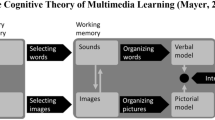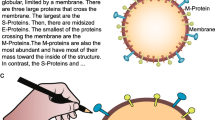Abstract
Using schema theory as a framework, we view learning as an active, constructive process. It is affected not only by learners' internal knowledge structures, but by the external constraints of the learning environment as well (Kozma, 1991). This article examines how different internal learner characteristics (e.g., prior knowledge, self efficacy and interest) and different external constraints (e.g., learner control, instructional design and level of control) influence the learning process. Specifically, we address learning from a variety of multimedia environments such as video, hypertexts, kiosks and other hypermedia within a schema theoretic approach that incorporates a constructivist view.
Similar content being viewed by others
References
Anderson, R.C. and Pearson, P.D. (1984). A schema-theoretic view of basic processes in reading comprehension, in P.D. Pearson, ed., Handbook of Reading Research (pp. 255–291). New York: Longman.
Anderson-Inman, L. and Horney, M.A. (1993). Profiles of Hypertext Readers: Results of the Electrotext Study. Paper presented at the annual meeting of the American Educational Research Association, Atlanta, Georgia.
Armbruster, B.B. (1986). Schema theory and the design of content-area textbooks. Educational Psychologist 21: 253–267.
Bandura, A. (1977). Self-efficacy: Toward a unifying theory of behavior. Psychological Review 84: 191–215.
Barab, S.A., Bowdish, B.E. and Lawless, K.A. (1996). Hypermedia navigation: Characterizing the emergent interpretation. Manuscript submitted for publication.
Barab, S.A., Bowdish, B.E., Young, M.F. and Owen, S.V. (in press). Understanding Kiosk navigation: Using log files to capture hypermedia searches. Instructional Science.
Barab, S.A., Fagen, B.R., Kulikowich, J.M. and Young, M.F. (1996). Assessing hypertext navigation through Pathfinder: Prospects and limitations. Manuscript under review for publication.
Barab, S.A., Young, M.F. and Shaw, R. (1996). Anchors as naturalistic constraints on hypertext navigation. Manuscript submitted for publication.
Binder, C. (1989). Hypertext design issues. Performance Improvement Quarterly 2(3): 16–33.
Bowdish, B.E., Barab, S.A. and Lawless, K.A. (October, 1994). The Kiosk Project. Paper presented at the annual meeting of the Northeastern Educational Research Association, Ellenville, New York.
Brown, J.S., Collins, A. and DuGuid, P. (1989). Situated cognition and the culture of learning. Educational Researcher Jan.-Feb.: 32–42.
Bruner, J.S. (1973). Beyond the Information Given. New York: Norton.
Campizzi, J.A. (1978). Effects of locus of control and provision of overviews in a computer-assisted instruction sequence. AEDS Journal.
Carver, S.M., Lehrer, R., Connell, T. and Erickson, J. (1992). Learning by hypermedia design: Issues of assessment and implementation. Educational Psychologist 27: 385–404.
Charney, D. (1987). Comprehending non-linear text: The role of discourse cues and reading strategies, in J. Smith and F. Halasz, eds., Hypertext '87 Proceedings (pp. 109–120). New York: Association for Computing Machinery.
Craik, F.I.M. and Lockhart, R.S. (1972). Levels of Processing: A Framework for Memory Research on Interactions. New York: Irvington.
Cronbach, L.J. and Snow, R.E. (1977). Aptitudes and Instructional Methods: A Handbook for Research Interaction. New York: Irvington.
Dillon, A. (1991). Readers' models of text structure: The case of academic materials. International Journal of Man-Machine Studies 35: 913–925.
Fernald, P.S., Chiseri, M.J. and Lawson, D.W. (1975). Systematic manipulation of student pacing, the perfection requirement, and contact with a teaching assistant in an introductory psychology course. Teaching of Psychology 2: 147–151.
Fincher-Kiefer, R., Post, T.A., Greene, T.R. and Voss, J.F. (1988). On the role of prior knowledge and task demands in the processing of text. Journal of Memory and Language 27: 416–428.
Fowler, J.F. (1983). Use of computer-assisted instruction in introductory management science. Journal of Experimental Education 52: 22–26.
Fry, J.P. (1972). Interactive relationship between inquisitiveness and student control of instruction. Journal of Educational Psychology 63: 459–465.
Gall, J.E. and Hannafin, M.J. (1994). A framework for the study of hypertext. Instructional Science 22: 207–232.
Gay, G. (1986). Interaction of learner control and prior understanding in computer-assisted video instruction. Journal of Educational Psychology 78(3): 225–227.
Goetzfried, L. and Hannafin, M.J. (1985). The effect of the locus of CAI control strategies on the learning of mathematics rules. American Educational Research Journal 22: 273–278.
Grabinger, R.S., Dunlap, J.C. and Jonassen, D.H. (1993). Relational links. Performance & Instruction: 35–40.
Gray, S.H. (1987). The effect of sequence control on computer-assisted learning. Journal of Computer-Based Instruction 2: 54–56.
Guthrie, J.T. and Dreher, M.J. (1990). Literacy as search: Explorations via computer, in D. Nix and R. Spiro, eds., Cognition, Education, Multimedia: Exploring Ideas in High Technology. Hillsdale: Erlbaum.
Hannafin, M.J. (1984). Guidelines for using locus of instructional control in the design of computer-assisted instruction. Journal of Instructional Development 7(3): 6–10.
Hannafin, R.D. and Sullivan, H.J. (1996). Preferences and learner control over amount of instruction. Journal of Educational Psychology 88: 162–173.
Holmes, E.H., Robson, E.H. and Steward, A.P. (1985). Learner control in computer-assisted learning. Journal of Computer Assisted Learning 1: 99–107.
Jacobson, M.J. and Spiro, R.J. (1995). Hypertext learning environments, cognitive flexibility, and the transfer of complex knowledge: An empirical investigation. Journal of Educational Computing Research 12(4): 301–333.
Jonassen, D.H. (1986). Hypertext principles for text and courseware design. Educational Psychologist 21(4): 269–292.
Jonassen, D.H. and Wang, S. (1993). Acquiring structural knowledge from semantically structured hypertext. Journal of Computer Based Instruction 20(1): 1–8.
Judd, W.A. (1972). Learner-controlled computer-assisted instruction. ERIC #ED 072-635.
Kozma, R.B. (1991). Learning with media. Review of Educational Research 6(2): 179–211.
Lahey, G.F. (1976). Learner control of lesson strategy: A model for PLATO IV system lessons. ERIC #ED 125-543.
Lahey, G.F., Hurlock, R.E. and McCann, P.H. (1973). Post-lesson remediation and student control of branching in computer-based learning. ERIC #ED 083-797.
Lawless, K.A. and Kulikowich, J.M. (in press). Understanding hypertext navigation through cluster analysis. Journal of Educational Computing Research.
Lawless, K.A. and Kulikowich, J.M. (1993, October). Assessment of Students' Navigation and Comprehension of a Hypertext Document. Paper presented at the annual meeting of the Northeastern Educational Research Association, Ellenville, NY.
Lawless K.A. and Kulikowich, J.M. (1994, February). Reading Comprehension, Navigation and Hypertext. Paper presented at the annual meeting of the Southwestern Educational Research Association, San Antonio, Texas.
Lawless, K.A. and Kulikowich, J.M. (1995, April). Domain Knowledge, Interest, and Hypertext Navigation: A Study of Individual Differences. Paper presented at the annual meeting of the American Educational Research Association, San Francisco, CA.
Lepper, M. (1985). Microcomputers in education: Motivational and social issues. American Psychologist 40: 1–18.
Mayer, R.E. (1976). Some conditions of meaningful learning for computer programming: Advance organizers and subject control of frame order. Journal of Educational Psychology 68(2): 143–150.
Merrill, M.D. (1975). Learner control: Beyond aptitude-treatment interactions. AV Communications Review 23: 217–226.
Merrill, M.D. (1983). Component display theory, in C.M. Reigeluth, ed., Instructional Design Theories and Models: An Overview of Their Current Status. Hillsdale: Erlbaum Associates.
Merrill, M.D. (1984). What is learner control? Instructional Development: The state of the art II. ERIC #ED 298-905.
Milheim, W.D. and Azbell, J.W. (January, 1988). How past research on learner control can aid in the design of interactive video materials. ERIC #ED 295-625.
Newkirk, R.L. (1973). A comparison of learner control and machine control strategies for computer-assisted instruction. Programmed Learning and Educational Technology 10: 82–91.
Owen, S.V. and Froman, R.D. (1992). Academic self-efficacy in elementary students. Journal of Research in Education 2: 3–7.
Papert, S. (1980). Mindstorms: Children, Computers and Powerful Ideas. New York: Basic Books.
Park, I. and Hannafin, M.J., (1993). Empirically-based guidelines for the design of interactive multimedia. Educational Technology Research and Development 41(3): 63–85.
Reigeluth, C.M. and Stein, F.S. (1983).The elaboration theory of instruction, in C.M. Reigeluth, ed., Instructional Design Theories and Models: An Overview of Their Current Status. Hillsdale: Erlbaum.
Ross, S.M. (1984). Matching the lesson to the student: Alternative adaptive designs for individualized learning systems. Journal of Computer-Based Instruction 11: 42–48.
Ross, S.M. and Rakow, E.A. (1981). Learner control versus program control as adaptive strategies for selection of instructional support on math rules. Journal of Educational Psychology 73: 745–753.
Scardamalia, M. and Bereiter, C. (1992). Text-based and knowledge-based questioning by children. Cognition and Instruction 9(3): 177–199.
Scardamelia, M., Bereiter, C., McLean, R., Swallow, J. and Woodruff, E. (1989). Computer supported intentional learning environments. Journal of Educational Computing Research 5: 51–68.
Schunk, D.H. (1989). Self-efficacy and cognitive skill learning, in C. Ames and R. Ames, eds., Research on Motivation in Education, Vol. 3. San Diego: Academic Press.
Shin, E.C., Schallert, D.L. and Savenye, W.C. (1994). Effects of learner control, advisement, and prior knowledge on young students' learning in a hypertext environment. Educational Technology, Research and Development 42(1): 33–46.
Shyu, H.S. and Brown, S.W. (1992). Learner control versus program control in interactive videodisc instruction: What are the effects in procedural learning? International Journal of Instructional Media 19(2): 85–96.
Shyu, H.S. and Brown, S.W. (1993). A study of interactive learning: IVS and diagrams. Computers in the Schools 94(4): 71–80.
Shyu, H.S. and Brown, S.W. (1995). Learner-Control: The effects on learning a procedural task during computer-based videodisc instruction. International Journal of Instructional Media 22(3): 217–231.
Snow, R.E. (1980). Aptitude, learner control, and adaptive instruction. Educational Psychologist 15: 151–158.
Spiro, R.J. and Jehng, J. (1990). Cognitive flexibility and hypertext: Theory and technology for the non-linear and multi-dimensional traversal of complex subject matter, in D. Nix and R. Spiro, eds., Cognition, Education, Multimedia: Exploring Ideas in High Technology (pp. 163–205). Hillsdale: Erlbaum.
Spiro, R.J., Feltovich, P., Jacobson, M. and Coulson, R. (1992). Cognitive flexibility, constructivism, and hypertext: Random access instruction for the advanced knowledge acquisition in ill-structured domains, in T. Duffy and D. Jonassen, eds., Constructivism and the Technology of Instruction (pp. 57–76). Hillsdale: Erlbaum.
Spiro, R.J., Vispoel, W.P., Schmitz, J.G., Samarapungavan, A. and Boerger, A.E. (1987). Knowledge acquisition for application: Cognitive flexibility and transfer in complex con tent domains, in B.K. Britton and S.M. Ortony, eds., Executive Control Processes in Reading (pp. 177–199). Hillsdale: Erlbaum.
Steinberg, E.R. (1977). Review of student control in computer-assisted instruction. Journal of Computer-Based Instruction 3(3): 84–90.
Tobias, S. (Winter, 1976). Achievement treatment interaction. Review of Educational Research 46: 61–74.
Tobias, S. (1981). Adapting instruction to individual differences among students. Educational Psychologist 16: 111–120.
Tulving, E. and Thompson, D.M. (1973). Encoding specificity and retrieval processes in episodic memory. Psychological Review 80: 352–373.
Wilson, B.G. and Jonassen, D.H. (1989). Hypertext and instructional design: Some preliminary guidelines. Performance Improvement Quarterly 2(3): 34–49.
Wittrock, M.C. (1978). Developmental processes in learning from instruction. Journal of Genetic Psychology 132: 37–54.
Wixson, K. and Peters, C. (1984). Reading redefined: A Michigan Reading Association position paper. The Michigan Reading Journal 17: 4–7.
Young, M.F. and Kulikowich, J.M. (1992, April). Anchored Instruction and Anchored Assessment. Paper presented at the annual meeting of the American Educational Research Association, San Francisco, CA.
Author information
Authors and Affiliations
Rights and permissions
About this article
Cite this article
LAWLESS, K.A., BROWN, S.W. Multimedia learning environments: Issues of learner control and navigation. Instructional Science 25, 117–131 (1997). https://doi.org/10.1023/A:1002919531780
Issue Date:
DOI: https://doi.org/10.1023/A:1002919531780




